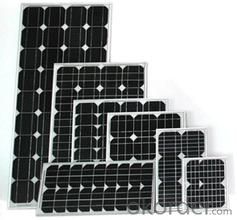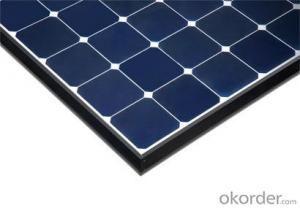Poly Solar Panel 25W A Grade with 12 Years Warranty
- Loading Port:
- Shanghai
- Payment Terms:
- TT OR LC
- Min Order Qty:
- 100 watt
- Supply Capability:
- 1000 watt/month
OKorder Service Pledge
OKorder Financial Service
You Might Also Like
Item specifice
Poly Solar Panel 25W A Grade with 12 Years Warranty
Production description
Photovoltaics were initially solely used as a source of electricity for small and medium-sized applications, from the calculator powered by a single solar cell to remote homes powered by an off-grid rooftop PV system. As the cost of solar electricity has fallen, the number of grid-connected solar PV systems has grown into the millions and utility-scale solar power stations with hundreds of megawatts are being built. Solar PV is rapidly becoming an inexpensive, low-carbon technology to harness renewable energy from the Sun.
The International Energy Agency projected in 2014 that under its "high renewables" scenario, by 2050, solar photovoltaics and concentrated solar power would contribute about 16 and 11 percent, respectively, of the worldwide electricity consumption, and solar would be the world's largest source of electricity. Most solar installations would be in China and India.[2]
Photovoltaics were initially solely used as a source of electricity for small and medium-sized applications, from the calculator powered by a single solar cell to remote homes powered by an off-grid rooftop PV system. As the cost of solar electricity has fallen, the number of grid-connected solar PV systems has grown into the millions and utility-scale solar power stations with hundreds of megawatts are being built. Solar PV is rapidly becoming an inexpensive, low-carbon technology to harness renewable energy from the Sun.
Commercial concentrated solar power plants were first developed in the 1980s. The 392 MW Ivanpah installation is the largest concentrating solar power plant in the world, located in the Mojave Desert of California. The 579 MW Solar Star, nearRosamond, California, is the world's largest PV power station.
Application
Commercial
Industrial
Residential
Product Feature
12 years quality warranty 25 years performance output.
Free for less than 5 pcs sample requirement
Free to replace or repair or refund if products fail to conform to the PI requirement.
Packaging
28pcs into carton 2carton into pallets 28pallets into a 40ft container
Delivery
After 25 days for manufacturered goods as soon as we received full payment.
After 10 days for stock goods as soon as we received full payment.
- Q:Can solar cells be used on boats?
- Yes, solar cells can be used on boats. In fact, they are a popular and efficient way to generate electricity on marine vessels. Solar panels can be mounted on the deck or roof of a boat to harness sunlight and convert it into usable energy, powering various devices and systems onboard. This renewable energy source is environmentally friendly, reduces reliance on fuel-powered generators, and provides a sustainable solution for boats to generate electricity while out on the water.
- Q:Can solar cells be used on backpacks or camping gear?
- Yes, solar cells can be used on backpacks or camping gear. They can be integrated into the design of backpacks or attached to camping gear to harness solar energy and convert it into electricity, allowing for convenient charging of devices or powering small electronics while on the go.
- Q:Which Solar Panel Type is best? Polycrystalline panel or PV Module Monocrystalline Solar cell panel, or thin film?
- Monocrystalline silicon solar panels are space-efficient. Monocrystalline solar panels produce up to four times the amount of electricity as thin-film solar panels.
- Q:How do solar cells impact local economies?
- Solar cells can have a positive impact on local economies in several ways. Firstly, the installation and maintenance of solar energy systems create job opportunities, contributing to local employment rates. Additionally, solar energy reduces the dependence on fossil fuels, which can lead to a decrease in energy costs for businesses and households, thereby stimulating economic growth. Moreover, the use of solar cells promotes energy independence, reducing the need for importing energy and keeping money within the local economy. Overall, solar cells can foster job creation, cost savings, and energy autonomy, all of which contribute to a stronger and more sustainable local economy.
- Q:What is the most commonly used material for solar cells?
- In terms of energy conversion efficiency and sustainability, the silicon and polycrystalline silicon cells are superior to amorphous silicon cells. Polycrystalline silicon conversion efficiency is low, but the price is cheaper.
- Q:What is the lifespan of a solar cell?
- The lifespan of a solar cell varies depending on several factors such as the quality of materials used, manufacturer specifications, and environmental conditions. However, on average, most solar cells have a lifespan of around 25 to 30 years.
- Q:Can solar cells be used in combination with batteries?
- Yes, solar cells can be used in combination with batteries. The electricity generated by solar cells during the day can be stored in batteries for later use, allowing for a continuous supply of power even when the sun is not shining or during power outages. This combination is commonly used in solar energy systems to enhance their reliability and provide a sustainable source of electricity.
- Q:How are solar cells used in military applications?
- Solar cells are used in military applications to power various equipment and devices in the field, such as communication systems, surveillance equipment, and remote sensors. They provide a reliable and sustainable source of energy, reducing the need for traditional fuel-based generators and minimizing logistical challenges. Additionally, solar cells can be integrated into portable and lightweight systems, enabling soldiers to operate efficiently in remote areas or during extended missions.
- Q:Can solar cells be used in satellite or space exploration missions?
- Yes, solar cells can be used in satellite or space exploration missions. In fact, they are extensively utilized in these missions to provide power to spacecraft and satellites due to their ability to convert sunlight into electricity efficiently.
- Q:How do solar cells perform in areas with high humidity?
- Solar cells generally perform slightly less efficiently in areas with high humidity. The moisture in the air can create a barrier between the sunlight and the solar cells, reducing their ability to convert sunlight into electricity. However, advancements in solar cell technology have improved their performance in high humidity conditions, making them still viable and effective in such areas.
1. Manufacturer Overview |
|
|---|---|
| Location | |
| Year Established | |
| Annual Output Value | |
| Main Markets | |
| Company Certifications | |
2. Manufacturer Certificates |
|
|---|---|
| a) Certification Name | |
| Range | |
| Reference | |
| Validity Period | |
3. Manufacturer Capability |
|
|---|---|
| a)Trade Capacity | |
| Nearest Port | |
| Export Percentage | |
| No.of Employees in Trade Department | |
| Language Spoken: | |
| b)Factory Information | |
| Factory Size: | |
| No. of Production Lines | |
| Contract Manufacturing | |
| Product Price Range | |
Send your message to us
Poly Solar Panel 25W A Grade with 12 Years Warranty
- Loading Port:
- Shanghai
- Payment Terms:
- TT OR LC
- Min Order Qty:
- 100 watt
- Supply Capability:
- 1000 watt/month
OKorder Service Pledge
OKorder Financial Service
Similar products
New products
Hot products
Related keywords


























